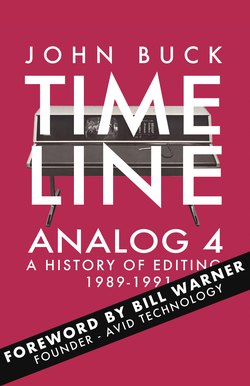Читать книгу Timeline Analog 4 - John Buck - Страница 11
На сайте Литреса книга снята с продажи.
THE WHIZ
ОглавлениеPete Fasciano and Tom Sprague’s VizWiz had started with a TR-5 VTR, a timebase corrector and an IVC camera crammed into a small van. With a run of success the company had evolved into a dedicated 20,000 feet facility in downtown Boston.
We were a very active company of 50 people using five editing suites, audio mixing suites, a large dedicated studio, 2 Postbox systems and a design area. So we knew a thing or two about post and editing but we were also seen as being innovators. In November, Bill Warner made a time to come in and talk with me and to get my feedback on what he was doing.
He had just hired Jeff Bedell, in fact I recall it was Jeff's first day and he showed me a VHS copy of the hypercard UI demonstration that he and Jeff had created.
I watched it a few times and listened to what Bill had to say and then I offered up my opinion. I said, "I understand the technology, I know what you want to do but this is not the way editors think. Give me a few weeks, I will write a paper for you and perhaps we can talk again".
Fasciano diligently plotted out what a digital nonlinear editing system needed to do, to be successful.
Bill knew that I had come to be known as the video wizard of Boston, hence the name of the company VizWiz. Bill and I talked on the phone a few times and then we had a second meeting of five hours where I went through the document I had written. I explained to him some of the larger concepts of videotape based postproduction versus film editing, as well as what I saw as the key areas he needed to focus on. Bill code named the editing system I had outlined as the Oz.
The "Oz System" was probably more appealing to video editors than film editors. It had a Record and Play interface (his notes above) made popular by linear systems in edit suites using video machines and it was based upon the need to use timecode for trimming, editing and finessing.
A paragraph from his notes included:
Online and offline editing systems up until now have been largely the same. Offline systems are simply less expensive versions of online systems and, therefore, subject to similar creative constraints with respect to speed and linearization of the video editing process. Normal offline systems are not faster or more flexible than online systems. They are simply cheaper and that's the only advantage they enjoy.
Jeff Bedell recalls.
We left that demo with Pete and agreed that we needed another UI. It was originally going to be a two-monitor approach like basic tape-to-tape editing but with a touch screen UI that was more modal. With touch-screen back then the area of sensitivity for a screen was at odds with what we needed so we dropped that and focused on the simpler iteration that Fasciano had outlined in his Oz brief
Warner spent weeks collating his research from various industry sources as Fasciano adds:
He rang me with few questions and then invited me to come out to Avid at the start of the year.
Eric Peters wished he could contribute more to Avid than just his spare time and weekends, but he had good reasons not to leave his full-time position with Apollo Computer. It wasn't that he doubted Bill Warner, or the start-up's chances of success. Peters and his wife had just completed the home study process of adopting their second child.
Having waited months for the U.S. Immigration and Naturalization Service to process their paperwork, Peters knew that a move away from a safe job at Apollo could jeopardise their adoption.
We had to prove that we were, as they say 'stable' people. So we waited.
Using accrued leave, Peters joined Warner at SMPTE in Los Angeles in November 1987.
We went to the show to try and figure what was going on with the industry and talked to as many editors as we could find. We would ‘button hole’ editors in lobbies, anywhere we could find them and after the initial shock they were fascinated by the possibilities that we were proposing. What do you think about not having to push a sequence of buttons to do one edit?
People were very generous with us and told us lots of things it would need to do and I had a notebook and scribbled down lots and lots of feedback.
Peters' written notes defined the make-up of the first Avid/1 editing system.
